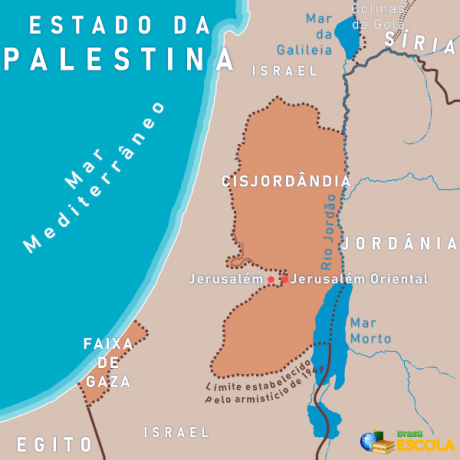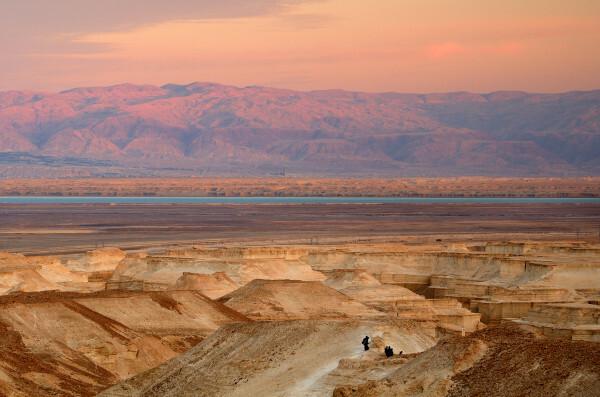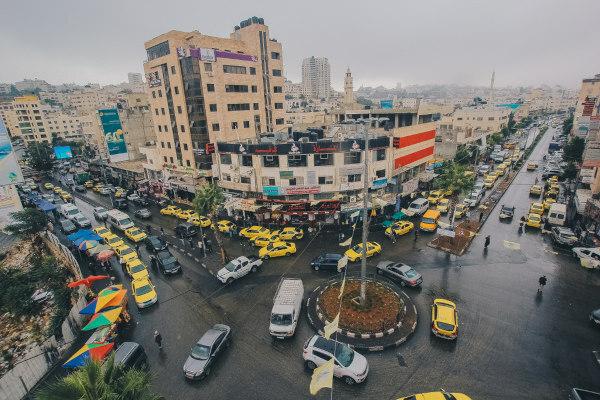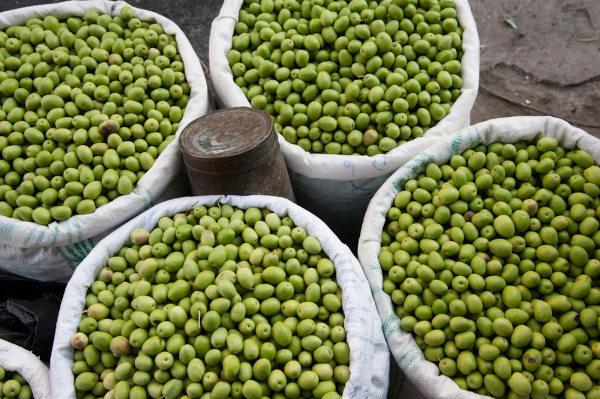A West Bank is a region that integrates the territory of Palestine. Located east of Israel and west of Jordan, this area extends over 5,860 km² and has a temperate climate. continental and arid, in addition to mountainous relief and deserts interrupted by vegetation covers such as steppes and fields.
It is a region far from the ocean, bathed by the Jordan River and the Dead Sea. The West Bank currently holds 60% of Palestine's population, more than 3.2 million inhabitants, who live in the 11 cities or administrative areas that make up this region. Its economy is based on the service sector and irrigated agriculture, with a low level of industrialization.
Read too: Palestine Question — the struggle of Palestinians for recognition of their territory
Topics in this article
- 1 - Summary about the West Bank
- 2 - General data on the West Bank
- 3 - Map of the West Bank
- 4 - Geography of the West Bank
- 5 - Demographics of the West Bank
- 6 - West Bank Economy
- 7 - Infrastructure of the West Bank
- 8 - Government of the West Bank
- 9 - Etymology of West Bank
- 10 - Culture of the West Bank
- 11 - History of the West Bank
- 12 - Curiosities about the West Bank
Summary about the West Bank
The West Bank is part of the territory of Palestine along with with the Gaza Strip.
It extends over 5,860 km² to the east of Israel and west of Jordan, a territory with which it is bordered by the Jordan River. To the southeast, the West Bank is bathed by the Dead Sea.
It has areas that are occupied by Israeli settlements. The regions governed by the Palestinian Authority are the 11 cities or administrative areas of the West Bank.
The headquarters of the Palestinian Authority are in Ramallah. The city of Jerusalem is also claimed as the Palestinian capital.
The West Bank has a temperate continental and arid climate, with mountainous and plain relief (to the east) with vegetation made up of deserts, steppes and grassland areas.
It is home to 3,256,906 inhabitants, which represents almost 60% of the population of Palestine. Most of this population lives in cities, such as Hebron.
Its economy is based on the tertiary sector and agriculture, with emphasis on irrigated agriculture that produces olives, cucumbers, tomatoes and other vegetables.
The region has limited infrastructure and depends on neighboring territories for services such as electricity distribution.
The culture of the West Bank is characterized by the Islamic religion (mostly Sunni) and by expressions such as oral literature and written poetry, music and typical dances.
Part of Palestine, the West Bank has already been integrated into the Ottoman and British empires, in addition to being under Israeli rule for a period during the second half of the 20th century.
General data for the West Bank
Official name: West Bank (Arabic: Al-Ḍaffah al-Gharbīyah).
Kind: Palestinian.
Territorial extension: 5,860 km².
Location: Middle East.
Climate: temperate continental and semiarid.
Government: parliamentarism led by the Palestinian Authority.
Administrative division: 11 cities or administrative areas.
Language: Arabic and Hebrew.
-
Religions:
Islamic: 80 to 85% of the population, the majority being Sunni;
Judaism: 12 to 14%;
Christianity: 1 to 2.5%;
other or unspecified: less than 1%.
Population: 3,256,906 inhabitants (estimate).
Demographic density: 555.7 inhabitants/km².
Human Development Index (HDI): 0.685 to 0.708, varying depending on the administrative area considered.
Coin: Israeli shekel, dollar, euro, Jordanian dinar.
Gross Domestic Product (GDP): US$ 17 billion (Palestine).
GDP per capita: US$3,424.5 (Palestine).
Gini: 0.337 (Palestine).
Time zone: GMT +2.
Foreign relations: Being part of Palestine, the West Bank is part of the UN as a non-member observer state.
Do not stop now... There's more after the advertising ;)
Map of the West Bank
O map in the following image indicates the situation geographical of the West Bank in the territory of Palestine. However, it is important to emphasize that the area under the government of the Palestinian Authority in the West Bank does not correspond to all the locations within the border established by the 1949 armistice. Within this demarcated area there are settlements belonging to Israel and also portions that are under Jordanian and Egyptian control. There are many enclaves belonging to the West Bank in this area, therefore it is not a continuous surface as it appears on the map.

Geography of the West Bank
The West Bank is one of the regions that make up the territory of Palestine, which is also formed by the Gaza Strip. The West Bank has an area of 5,860 km² and is located east from Israel and to the west from Jordan, from which it is separated by ri Jordan. Although it has no outlet to the Mediterranean Sea, the West Bank is bathed, to the southeast, by the Dead Sea. It is in the West Bank where the headquarters of the Palestinian Authority are located, more precisely in Ramallah.
Jerusalem is claimed as the capital of the Palestinian territory, even though this is one of the obstacles established between Palestine and Israel, as the country also aims to recognize this city as its capital. Currently, Israel exercises dominance over the so-called East Jerusalem.
The West Bank is divided into 11 administrative units, also called cities. Are they:
Hebron |
Tucarém |
Jericho |
Bethlehem |
Jenim |
Nablus |
Calquilia |
Salfit |
Tubas |
Jerusalem (claimed capital) |
Ramallah (headquarters of the Palestinian Authority) |
The region has a climate that varies from temperate continental to arid, with local conditions that are influenced by the relief. The West Bank experiences hot or moderate summers, depending on the location, and rainy, cold winters. The average temperatures recorded in West Bank cities are around 22º C, while the Annual precipitation varies from approximately 650 mm in the wettest areas to 100 mm in drier areas, how next of the Dead Sea.

Mountainous and rugged terrain, with an average altitude between 700 and 900 meters, characterize the relief of the West Bank, with emphasis on the relief unit that crosses the region from north to south and is called the Samarian Hills, north of Jerusalem, and becomes known as the Judean Hills, south of Jerusalem. city. As you approach the Jordan River, the main watercourse that borders the West Bank and borders Jordan, you can see a reduction in altitude and a flattening of the relief.
As it is a region where rainfall is low and air humidity is low, there is formation of large desert areas, such as the Judean Desert. However, in areas where there is greater water availability, even aquifer areas in the middle of the desert, the development of field covers is observed, similar to savannas, and steppes.
Read too: Middle East — everything about one of the most conflictual regions on the planet
Demographics of the West Bank
The West Bank has a 59.3% of the entire population of Palestine, which stands for 3.256.906 population according to official estimates from the Palestinian Central Statistical Office. A large part of the West Bank population lives in the western portion of the territory, concentrated in cities such as Hebron, which is the largest urban center in the region, with more than 822 thousand inhabitants, Nablus and Ramallah. In the midst of the areas under Palestinian administration there are also Israeli settlements, which have 432 thousand inhabitants. Most of them inhabit East Jerusalem.

Due to the conflicts that occur recurrently in the West Bank region, its migration balance ends up being negative, ranking among the largest in the world. Most of these people who leave the Palestinian territory leave there in refugee status. Despite this, the local population grows due to the high number of births and comparatively low number of deaths. The population growth rate in the West Bank is currently 1.6% per year.
The population of the West Bank, as well as the Gaza Strip, is fformed mainly by young people, with a median age of 21.9 years. As a result, there is a high dependency rate among the younger population, which is ten times higher than the dependency rate among the elderly population. With an average level of development, and higher than that observed in the Gaza Strip, the life expectancy of residents of the West Bank is 76.6 years.
West Bank Economy
The West Bank economy stands out compared to the Gaza Strip, although it cannot be considered a developed or strong economy either. It is estimated that the region's GDP is approximately 10 billion dollars. However, these values are not updated and are from 2014. Taking this data into account, we could conclude that the majority of Palestine's GDP, which is 17 billion dollars, is derived from the West Bank.
The West Bank experienced a brief period of industrial development during the 20th century, but even so, it presents a very rudimentary industry characterized by small-scale factories, with a few dozen employees and for the production of soap and wooden and mother-of-pearl objects, which serve as souvenirs for visitors acquire. Furthermore, the textile segment and the extractive industry make up the secondary sector in the region.
A Agriculture in the West Bank is developed with the help of irrigation, and its products include tomatoes, cucumbers, olives and potatoes, in addition to goat's milk derived from livestock farming. Despite the relevance of agriculture to the local economy, it is the tertiary sector which accounts for 77% of GDP.

About the West Bank economy, It is important to point out the impoverishment of the region following the occupation promoted by Israell in territories within the limits of the West Bank. Between 2000 and 2019, a UNCTAD study showed that this occupation cost the region 58 billion dollars, and that the local GDP should be around 44% above the current level. Unemployment in the West Bank is alarming (25%), the eighth highest rate in the world. The scenario is even more serious among young people in general (39.6%) and women aged 15 to 24 (69%).
West Bank Infrastructure
The infrastructure of the West Bank is precarious and, like its industrialization process, teve its development interruptedO due to the numerous conflicts that take place in the region. Access to basic services such as water and electricity depends on supply or distribution via neighboring territories, such as Israel and Jordan, as the region does not have the necessary physical network to such. It should also be noted that part of the electricity consumed in the West Bank is generated locally from renewable sources.
Transport within the West Bank is carried out by road, while travel International flights have as their starting or arrival point only two airports, which are located in Ramallah and Jenin.
West Bank Government
The West Bank is part of the self-determined State of Palestine, which does not have unanimous international recognition. To date, 138 countries, including Brazil, recognize Palestine as a state. Therefore, it is a region led by the Palestinian National Authority (ANP), an entity created in 1994, which implemented a provisional parliamentary government based in Ramallah.
Etymology of West Bank
In international diplomacy, the West Bank is called the West Bank, in English. This is the translation of the Arabic name, aḍ-Ḍiffah al-Ġarbiyyah, which refers to the geographic positioning of this region in relation to the rio Jordan: to the west. In languages of Latin origin, the term West Bank has recently become popular, also indicating the location of the area: “on this side of the Jordan River”.
West Bank Culture
The culture of the West Bank, which is the culture of the Palestinians, was built through of a series of elements and aspects acquired from peoples of the Middle East and Europe, such as Armenians, Greeks, Turks and Hebrews, as well as, of course, other Arab peoples. Palestinian Arabs and a smaller number of Israelis currently live in the territories led by the Palestinian Authority in the West Bank. Therefore, the languages spoken in the region are Arabic and Hebrew, although English is widely known.
Religion is a very important aspect of West Bank culture. Its population is mostly Sunni Muslim.
Stories passed down from generation to generation are a part of Palestinian culture in the West Bank, which includes the arabic legends that are heard by children from a very young age, legends that involve magical beings such as djinns. In addition to oral tradition, written literature and, above all, poetry represent local culture. Crafts and music are other expressions very present in the cultural life of Palestinians, in addition to dances such as dabke. In gastronomy, the preparations are accompanied by typical breads, olive oil, meats and lentils.
History of the West Bank
The history of the West Bank is the history of formation of the territory of Palestine, which remains a State not yet recognized internationally and which seeks its establishment as a sovereign and politically independent entity.
There were several people who passed through the region currently known as the West Bank, which had an enormous cultural contribution. Among these people were the Assyrians, Babylonians, Egyptians, Israelites and Persians. The Roman Empire also briefly exercised dominion over the area, and it was precisely under Roman tutelage that the location came to be called Palestine.
You Arab people began to settle in that region around the 7th century of the current era, its presence gaining more strength with the domination of the Ottoman Empire at the beginning of the 16th century, when part of the Palestinian territory was annexed to it. At the same time that Ottoman rule over the West Bank diminished, it grew the Zionist movement, which emerged at the end of the 19th century and advocated the return of the Jewish people to that region and the creation of their own state.
A The region became part of the British domains after the end of the First World War (1914-1918), a period that officially marked the end of the Ottoman Empire. In the meantime, and especially after the Second World War (1945-1949), the migratory movement of Jews to the region intensified and its demand for the creation of a State. This happened in 1948, one year after the partition of Palestine carried out by the United Nations (UN). However, the partition granted just under half of the territory to the Arabs, generating great dissatisfaction and giving rise to a series of territorial conflicts in the region.
In 1948 the first Arab-Israeli War, and it was during this conflict that the West Bank was annexed by Jordanian territory. The West Bank remained part of Jordanian territory until 1967, when it was incorporated by Israel during the Six Day War. The area, and other portions of what we now know as the territory of Palestine, were only transferred to the domain of the Palestinian Authority in the 1990s, with the Oslo Accords.
You Oslo Accords promoted the division of the West Bank into three different areas, one being completely governed by Palestine, the other by Israel and an area of mutual control. From the 2000s onwards, there was an escalation of conflicts in the region, which was aggravated with the victory of Hamas in the elections held in 2006. However, the Palestinian Authority regained power over the West Bank the following year, establishing a government favorable to Fatah, a moderate group linked to the Palestinian Liberation Organization (PLO).
Since then, tensions and armed conflicts between Israel and Palestine have become increasingly recurrent., both in the Gaza Strip and the West Bank. There was an escalation of these conflicts in the year 2022, which was considered one of the deadliest since the beginning of differences between Israel and Palestine. In 2023, an attack carried out by Hamas against Israel has led to a new wave of violence in the region. Although Israel's actions are concentrated in the Gaza Strip, territory governed by Hamas, some areas of the West Bank are also targets.
Curiosities about the West Bank
Despite the dry climate, arable land is the West Bank's main natural resource.
The highest point in the West Bank is called Khallat al Batrakh, and is 1,020 meters above sea level.
The Dead Sea, in turn, is the lowest point in the West Bank. Its greatest depth is 431 meters.
The Dead Sea is divided between the West Bank, Israel and Jordan and, although it receives this name, it corresponds to a huge lake formed by water with a high salinity content.
Image credits
[1] nayef hammouri / Shutterstock
Sources:
CIA. Countries: West Bank. The World Factbook. Available in: https://www.cia.gov/the-world-factbook/countries/west-bank/.
Palestinian Central Bureau of Statistics. Available in: http://www.pcbs.gov.ps/default.aspx.
THE EDITORS OF ENCYCLOPÆDIA BRITANNICA. Geography and Travel: West Bank (region, Palestine). Encyclopaedia Britannica, [2023]. Available in: https://www.britannica.com/place/West-Bank.
UNCTAD. The economic costs of the Israeli occupation for the Palestinian people: Arrested development and poverty in the West Bank. UNCTAD, 2021/2. Available in: https://unctad.org/publication/economic-costs-israeli-occupation-palestinian-people-arrested-development-and-poverty.
UNITED NATIONS. Date: State of Palestine. Available in: https://data.un.org/en/iso/ps.html.
Would you like to reference this text in a school or academic work? Look:
GUITARRARA, Paloma. "West Bank"; Brazil School. Available in: https://brasilescola.uol.com.br/geografia/cisjordania.htm. Accessed on October 18, 2023.
The Encceja PPL 2023 tests are held this Tuesday (17) and tomorrow (18). Click and...
Click and find out what the West Bank is. Read about the geography, population and economy of...
Access the link and find out what Hezbollah is. Understand the context in which this group emerged and its form...

